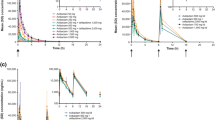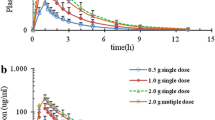Summary
The pharmacokinetics and in particular bioavailability of fosfomycin trometamol was studied and compared to the earlier emerging calcium salt formulation by administration of 50 mg/kg body weight orally of the two and an identical dose intravenously to all of eight healthy male volunteers. The serum and urine samples collected over 12 and 48 hours, respectively, were assayed microbiologically. The serum peak concentrations were 26.2 mg/l after trometamol and 6.5 mg/l after the calcium salt. Based on total area under the serum curves, the bioavailability of fosfomycin from the trometamol formulation was 42.3% compared to a mere 12% of the calcium salt. Urinary recovery was nearly completed within 12 hours, and the amounts eliminated in percentage of the doses were 87, 43, and 18% after the intravenous, the oral dose of trometamol and oral calcium salt, respectively. The serum half-life was 3.4 hours after intravenous administration, which demonstrates the inherent rate of elimination of fosfomycin. In comparison the half-life values were 3.6 hours after the trometamol dose, and 5.6 hours after the calcium salt. The longer elimination of the latter is explainable by the less complete absorption and consequent delayed absorption of fosfomycin from the calcium salt formulation. The antibacterial activity in urine upon administration of 50 mg/kg was prolonged to 48 hours in nearly all cases of trometamol orally and more than after the calcium salt orally or the sodium salt intravenously. A dose of 3 g for adults — or 50 mg/kg — is consistent with the findings in this study.
Zusammenfassung
Die Pharmakokinetik und insbesondere die Bioverfügbarkeit von Fosfomycin Trometamol wurde geprüft und mit den Eigenschaften einer bereits früher hergestellten Kalziumsalz-Präparation verglichen. Acht gesunde, freiwillige männliche Versuchspersonen erhielten oral und intravenös jeweils eine Wirkstoff-Dosis von 50 mg/kg Körpergewicht. Die Untersuchung der über 12 beziehungsweise 48 Stunden gesammelten Serum- und Urinproben erfolgte mikrobiologisch. Nach Gabe der Trometamol-Präparation wurden Serumspitzenkonzentrationen von 26,2 mg/l, nach Gabe des Kalziumsalzes von 6,5 mg/l gemessen. Aus der Gesamtfläche unter den Serumkonzentrationszeitkurven errechnete sich für die Fosfomycin-Trometamol-Präparation eine Bioverfügbarkeit von 42,3%, verglichen mit nur 12% für das Kalziumsalz. Nach 12 Stunden fand sich nahezu die gesamte Wirkstoffmenge im Urin wieder; der prozentuale Anteil der eliminierten, intravenös oder oral verabreichten Dosis der Trometamol-Präparation und der oralen Kalziumsalz-Präparation betrug 87, 43 und 18%. Nach intravenöser Gabe wurde eine Halbwertszeit von 3,4 Stunden gemessen, was der inhärenten Eliminationsrate des Fosfomycin entspricht. Für die orale Trometamol-Formulierung ergab sich eine Halbwertszeit von 3,6 Stunden, für das Kalziumsalz von 5,6 Stunden. Die längere Eliminationsdauer für das Kalziumsalz erklärt sich aus der geringeren und damit verzögerten Absorption von Fosfomycin aus dieser Präparation. Die antibakterielle Aktivität von Fosfomycin blieb nach oraler Gabe von 50 mg/kg der Trometamol-Präparation bei fast allen Versuchspersonen 48 Studen lang bestehen, sie hielt bei dieser Therapieform länger an als mit dem oralen Kalziumsalz oder intravenöser Gabe des Natriumsalzes. Die Dosierung von 3 g oder 50 mg/kg bei Erwachsenen steht in Einklang mit den Ergebnissen dieser Studie.
Similar content being viewed by others
References
Kestle, D. G., Kirby, W. M. M.: Clinical pharmacology andin vitro activity of phosphonomycin. Proceedings from ICAAC 1969. Antimicrob. Agents Chemother. 1970, 332–337.
Bundgaard, H. Acid-catalyzed hydrolysis of fosfomycin and its implication in oral absorption of the drug. Int. J. Pharmaceut. 6 (1980) 1–9.
Cardorniga, R., Diaz-Fierros, M., Olay, T. Pharmacokinetic study of fosfomycin and its bioavailability. Chemotherapy 23 (Suppl. 1) (1977) 159–174.
Goto, M., Sugiyama, M., Nakajima, S., Yamashina, H. Fosfomycin kinetics after intravenous and oral administration to human volunteers. Antimicrob. Agents Chemother. 20 (1981) 393–397.
Kirby, W. M. M. Pharmacokinetics of fosfomycin. Chemotherapy 23 (Suppl. 1) (1977) 141–151.
Kuemmerle, H. P., Murakawa, T., Sakamoto, H., Sato, N., Konishi, T., De Santo, F. Fosmidomycin, a new phosphonic acid antibiotic. Part II: 1. Human pharmacokinetics. 2. Preliminary early phase IIa clinical studies. Int. J. Clin. Pharmacol. Ther. Tox. 23 (1985) 521–528.
Shimizu, K. Fosfomycin: absorption and excretion. Chemotherapy 23 (Suppl. 1) (1977) 153–158.
Bergan, T., Di Mario, F., Mastropaolo, G., Naccarato, R. Pharmacokinetics of fosfomycin and influence of cimetidine and metoclopramide on the bioavailability of fosfomycin trometamol. In:Neu, H., Williams, J. D. (eds.): New trends in urinary tract infections. Karger, Basel 1988, pp. 157–166.
Borsa, F., Leroy, A., Fillastre, J. P., Godin, M., Moulin, G. Comparative pharmacokinetics of trometamine fosfomycin and calcium fosfomycin in young and elderly adults. Antimicrob. Agents Chemother. 32 (1988) 938–941.
Ferrari, V., Bonanomi, L., Borgia, M., Lodola, E., Marca, G. A new fosfomycin derivative with much improved bioavailability by oral route. Chemiotherapia Antimicrobica 4 (1981) 59–63.
Fillastre, J. P., Leroy, A., Humbert, G., Borsa, F., Josse, S. Comparative pharmacokinetics of trometamol-fosfomycin versus calciumfosfomycin in elderly subjects and uraemic patients. In:Neu, H., Williams, J. D. (eds.): New trends in urinary tract infections. Karger, Basel 1988, pp. 143–156.
Segre, G., Bianchi, E., Cataldi, A., Zannini, G., Pharmacokinetic profile of fosfomycin trometamol (Monuril). Eur. Urol. 13 (Suppl. 1) (1987) 56–63.
Wilson, P., Williams, J. D., Rolandi, E. Comparative pharmacokinetics of fosfomycin trometamol, sodium fosfomycin and calcium fosfomycin in humans. In:Neu, H., Williams, J. D. (eds.): New trends in urinary tract infections. Karger, Basel 1988, pp. 136–142.
Wagner, J. G. Fundamental of clinical pharmacokinetics. Drug Intelligence Publications, Hamilton, Ill. 1975, pp. 403–437.
Bergogne-Bérézin, E., Muller-Serieys, C., Joly-Guillou, M. L., Dronne, N. Trometamol-fosfomycin (Monuril) bioavailability and food-drug interaction. Eur. Urol. 13 (Suppl. 1) (1987) 64–68.
Muller-Serieys, C., Bergogne-Bérézin, E. Pharmacokinetics of fosfomycin trometamol (Monuril) in healthy volunteers. In:Neu, H., Williams, J. D. (eds.): New trends in urinary tract infections. Karger, Basel 1988, pp. 299–301.
Author information
Authors and Affiliations
Rights and permissions
About this article
Cite this article
Bergan, T. Degree of absorption, pharmacokinetics of fosfomycin trometamol and duration of urinary antibacterial activity. Infection 18 (Suppl 2), S65–S69 (1990). https://doi.org/10.1007/BF01643430
Issue Date:
DOI: https://doi.org/10.1007/BF01643430




